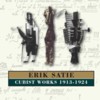 One of the most revered musical pioneers of the 20th century, Erik Satie also had connections to the avant-garde of other artistic disciplines. This album contains primarily his collaborations with Picasso and Cocteau, as well as a couple of other seldom heard works. Performed by Bojan Gorisek, who has recorded Satie's entire piano oeuvre, this is a playful and entertaining collection that presents another fascinating side of this eccentric composer.
One of the most revered musical pioneers of the 20th century, Erik Satie also had connections to the avant-garde of other artistic disciplines. This album contains primarily his collaborations with Picasso and Cocteau, as well as a couple of other seldom heard works. Performed by Bojan Gorisek, who has recorded Satie's entire piano oeuvre, this is a playful and entertaining collection that presents another fascinating side of this eccentric composer.
The most famous of these collaborations is Cocteau's controversial ballet Parade, which was specifically written to promote the aims of cubism. Cocteau commissioned Satie to compose the music and Picasso to design the set and the costumes, bizarre examples of which adorn the cover of this album. Two versions of this are presented here, one on piano and another with the backing of the New London Orchestra. Sound effects were performed along with the music in the original production of the ballet, predating Edgard Varese's similar tactic in Ameriques by several years. Yet the sound effects were imposed against Satie's wishes, and subsequently, they're left off of the piano version here yet restored on the orchestral version. The music is lively, betraying little of the theory behind his elegant yet innocuous "furniture music" or the endurance-testing Vexations. If anything, the melodies reflect Satie's previous day job performing at cabarets and music halls than his serious compositions. What makes them distinctly his, however, are the number of brief, tongue-in-cheek passages and their propensity for irresolution, something that irked many of the popular sensibilities of the day.
Mercure was also a ballet, and this time Picasso developed the scenario as well as designed the sets and costumes. Its premiere was a scandal of sorts, with elements of the Dada and Surrealist movements infighting and creating enough of a disturbance that the performance ended prematurely when members of the audience were arrested. The music of Mercure is, as its title suggests, a number of brief tracks that frequently shift moods unpredictably. Of these moods, several suggest the placidity of Satie's better-known material while plenty of the up-tempo sections keep things moving.
Also included is "Divertissement (La Statue Retrouvee)," a piece commissioned for a wealthy society figure's masked ball under the direction of Cocteau, with Picasso again doing the sets and costumes. The song is unique in that it was written for an organ and ends with an unexpected trumpet solo. Characteristically, the novelty's over all too briefly.
Satie rightly gets a lot of credit for changing the course of music with his unique ideas, which makes his collaborations with other highly regarded artists that much more intriguing. The performances on this collection are excellent, and I'm especially appreciative of the orchestral versions included here, sound effects and all. Gorisek and the New London Orchestra have done Satie justice, illustrating again why Satie's reputation continues to grow with age.
samples:
Read More

